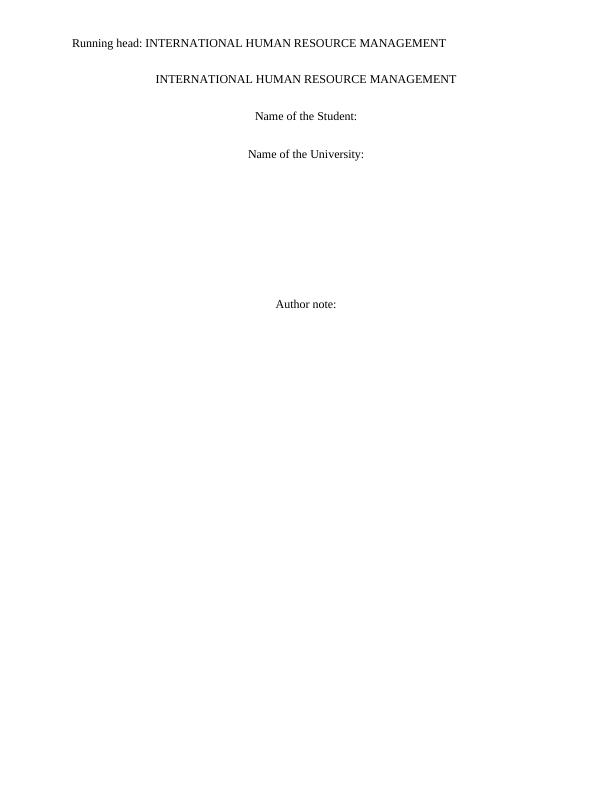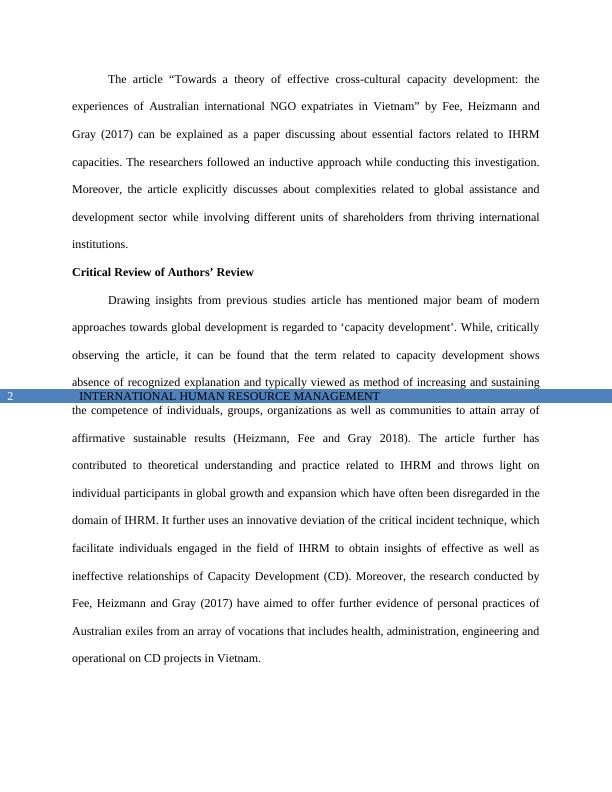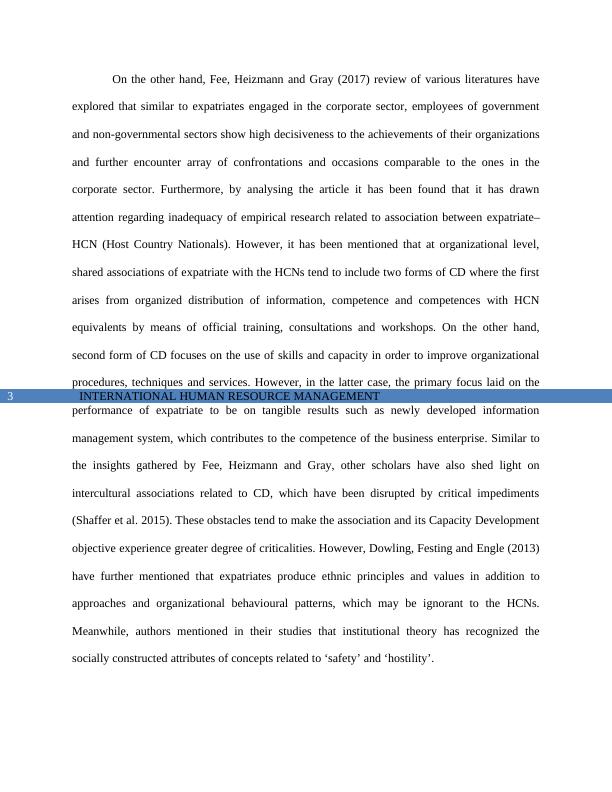Critical Analysis of International Human Resource Management
Added on 2022-12-26
13 Pages3740 Words65 Views
Running head: INTERNATIONAL HUMAN RESOURCE MANAGEMENT
INTERNATIONAL HUMAN RESOURCE MANAGEMENT
Name of the Student:
Name of the University:
Author note:
INTERNATIONAL HUMAN RESOURCE MANAGEMENT
Name of the Student:
Name of the University:
Author note:

INTERNATIONAL HUMAN RESOURCE MANAGEMENT1
Introduction
International Human Resource Management (IHRM) is known as the use of all HRM
events as they influence the progression of managing human resources in firms engaged in global
environment. Theorists have explained IHRM as extension of HR, which associates with people
working overseas. These employees can be either expatriate staffs or even nationals of third
countries (Collings, Wood and Szamosi 2018). The domain of IHRM primarily encompasses
development and training, performance assessment, remunerations, recruitment and selection and
labour relations. However, a critical challenge in the field of IHRM is the need to accomplish
target regarding competing pressures as well as demands of international integration and co-
ordination in response to domestic reactions and global versus local debate. Also primary
challenges in IHRM includes increased failure rates of transportation and repatriation in addition
to deployment and proper amalgamation of talent and competence and innovation, expertise and
managing critical knowledge along with rapidity of the flow of innovation (Brewster et al. 2016).
Drawing relevance to these factors, it is vital to note that IHRM has decisive role in
organizations who intend to successfully thrive in international market. Furthermore, IHRM
analyses the way in which global business firms deal with HR across these diverse national
contexts (Dowling, Festing and Engle 2013). The aim of the following essay is to critically
analyse an article dealing with IHRM issues regarding expatriates and review literature,
methodology, sampling, findings and evidences presented in the article to understand different
underlying factors related to IHRM.
Discussion
Critical Analysis of Article’s Research Paradigm and Focus
Introduction
International Human Resource Management (IHRM) is known as the use of all HRM
events as they influence the progression of managing human resources in firms engaged in global
environment. Theorists have explained IHRM as extension of HR, which associates with people
working overseas. These employees can be either expatriate staffs or even nationals of third
countries (Collings, Wood and Szamosi 2018). The domain of IHRM primarily encompasses
development and training, performance assessment, remunerations, recruitment and selection and
labour relations. However, a critical challenge in the field of IHRM is the need to accomplish
target regarding competing pressures as well as demands of international integration and co-
ordination in response to domestic reactions and global versus local debate. Also primary
challenges in IHRM includes increased failure rates of transportation and repatriation in addition
to deployment and proper amalgamation of talent and competence and innovation, expertise and
managing critical knowledge along with rapidity of the flow of innovation (Brewster et al. 2016).
Drawing relevance to these factors, it is vital to note that IHRM has decisive role in
organizations who intend to successfully thrive in international market. Furthermore, IHRM
analyses the way in which global business firms deal with HR across these diverse national
contexts (Dowling, Festing and Engle 2013). The aim of the following essay is to critically
analyse an article dealing with IHRM issues regarding expatriates and review literature,
methodology, sampling, findings and evidences presented in the article to understand different
underlying factors related to IHRM.
Discussion
Critical Analysis of Article’s Research Paradigm and Focus

INTERNATIONAL HUMAN RESOURCE MANAGEMENT2
The article “Towards a theory of effective cross-cultural capacity development: the
experiences of Australian international NGO expatriates in Vietnam” by Fee, Heizmann and
Gray (2017) can be explained as a paper discussing about essential factors related to IHRM
capacities. The researchers followed an inductive approach while conducting this investigation.
Moreover, the article explicitly discusses about complexities related to global assistance and
development sector while involving different units of shareholders from thriving international
institutions.
Critical Review of Authors’ Review
Drawing insights from previous studies article has mentioned major beam of modern
approaches towards global development is regarded to ‘capacity development’. While, critically
observing the article, it can be found that the term related to capacity development shows
absence of recognized explanation and typically viewed as method of increasing and sustaining
the competence of individuals, groups, organizations as well as communities to attain array of
affirmative sustainable results (Heizmann, Fee and Gray 2018). The article further has
contributed to theoretical understanding and practice related to IHRM and throws light on
individual participants in global growth and expansion which have often been disregarded in the
domain of IHRM. It further uses an innovative deviation of the critical incident technique, which
facilitate individuals engaged in the field of IHRM to obtain insights of effective as well as
ineffective relationships of Capacity Development (CD). Moreover, the research conducted by
Fee, Heizmann and Gray (2017) have aimed to offer further evidence of personal practices of
Australian exiles from an array of vocations that includes health, administration, engineering and
operational on CD projects in Vietnam.
The article “Towards a theory of effective cross-cultural capacity development: the
experiences of Australian international NGO expatriates in Vietnam” by Fee, Heizmann and
Gray (2017) can be explained as a paper discussing about essential factors related to IHRM
capacities. The researchers followed an inductive approach while conducting this investigation.
Moreover, the article explicitly discusses about complexities related to global assistance and
development sector while involving different units of shareholders from thriving international
institutions.
Critical Review of Authors’ Review
Drawing insights from previous studies article has mentioned major beam of modern
approaches towards global development is regarded to ‘capacity development’. While, critically
observing the article, it can be found that the term related to capacity development shows
absence of recognized explanation and typically viewed as method of increasing and sustaining
the competence of individuals, groups, organizations as well as communities to attain array of
affirmative sustainable results (Heizmann, Fee and Gray 2018). The article further has
contributed to theoretical understanding and practice related to IHRM and throws light on
individual participants in global growth and expansion which have often been disregarded in the
domain of IHRM. It further uses an innovative deviation of the critical incident technique, which
facilitate individuals engaged in the field of IHRM to obtain insights of effective as well as
ineffective relationships of Capacity Development (CD). Moreover, the research conducted by
Fee, Heizmann and Gray (2017) have aimed to offer further evidence of personal practices of
Australian exiles from an array of vocations that includes health, administration, engineering and
operational on CD projects in Vietnam.

INTERNATIONAL HUMAN RESOURCE MANAGEMENT3
On the other hand, Fee, Heizmann and Gray (2017) review of various literatures have
explored that similar to expatriates engaged in the corporate sector, employees of government
and non-governmental sectors show high decisiveness to the achievements of their organizations
and further encounter array of confrontations and occasions comparable to the ones in the
corporate sector. Furthermore, by analysing the article it has been found that it has drawn
attention regarding inadequacy of empirical research related to association between expatriate–
HCN (Host Country Nationals). However, it has been mentioned that at organizational level,
shared associations of expatriate with the HCNs tend to include two forms of CD where the first
arises from organized distribution of information, competence and competences with HCN
equivalents by means of official training, consultations and workshops. On the other hand,
second form of CD focuses on the use of skills and capacity in order to improve organizational
procedures, techniques and services. However, in the latter case, the primary focus laid on the
performance of expatriate to be on tangible results such as newly developed information
management system, which contributes to the competence of the business enterprise. Similar to
the insights gathered by Fee, Heizmann and Gray, other scholars have also shed light on
intercultural associations related to CD, which have been disrupted by critical impediments
(Shaffer et al. 2015). These obstacles tend to make the association and its Capacity Development
objective experience greater degree of criticalities. However, Dowling, Festing and Engle (2013)
have further mentioned that expatriates produce ethnic principles and values in addition to
approaches and organizational behavioural patterns, which may be ignorant to the HCNs.
Meanwhile, authors mentioned in their studies that institutional theory has recognized the
socially constructed attributes of concepts related to ‘safety’ and ‘hostility’.
On the other hand, Fee, Heizmann and Gray (2017) review of various literatures have
explored that similar to expatriates engaged in the corporate sector, employees of government
and non-governmental sectors show high decisiveness to the achievements of their organizations
and further encounter array of confrontations and occasions comparable to the ones in the
corporate sector. Furthermore, by analysing the article it has been found that it has drawn
attention regarding inadequacy of empirical research related to association between expatriate–
HCN (Host Country Nationals). However, it has been mentioned that at organizational level,
shared associations of expatriate with the HCNs tend to include two forms of CD where the first
arises from organized distribution of information, competence and competences with HCN
equivalents by means of official training, consultations and workshops. On the other hand,
second form of CD focuses on the use of skills and capacity in order to improve organizational
procedures, techniques and services. However, in the latter case, the primary focus laid on the
performance of expatriate to be on tangible results such as newly developed information
management system, which contributes to the competence of the business enterprise. Similar to
the insights gathered by Fee, Heizmann and Gray, other scholars have also shed light on
intercultural associations related to CD, which have been disrupted by critical impediments
(Shaffer et al. 2015). These obstacles tend to make the association and its Capacity Development
objective experience greater degree of criticalities. However, Dowling, Festing and Engle (2013)
have further mentioned that expatriates produce ethnic principles and values in addition to
approaches and organizational behavioural patterns, which may be ignorant to the HCNs.
Meanwhile, authors mentioned in their studies that institutional theory has recognized the
socially constructed attributes of concepts related to ‘safety’ and ‘hostility’.

End of preview
Want to access all the pages? Upload your documents or become a member.
Related Documents
MGT307 Functions of International HRMlg...
|7
|1905
|123
International Human Resource Managementlg...
|8
|2495
|434
The three most important HR practices for an International businesslg...
|14
|4201
|280
International performance managementlg...
|16
|3944
|19
International HRM: Recruitment, Training & HRISlg...
|25
|1623
|302
IHRM and Human Resource Management | Nestle Caselg...
|14
|3924
|122
